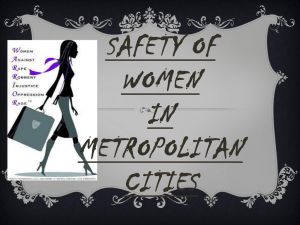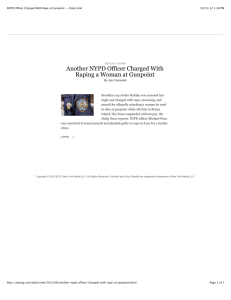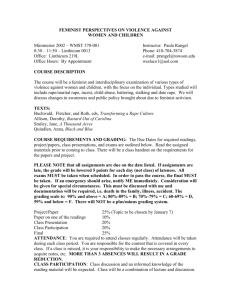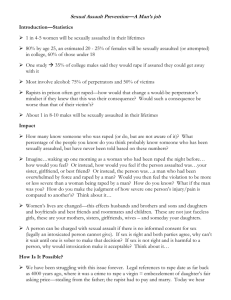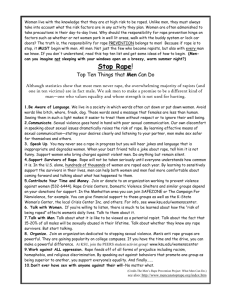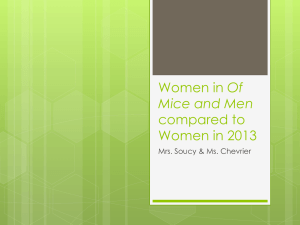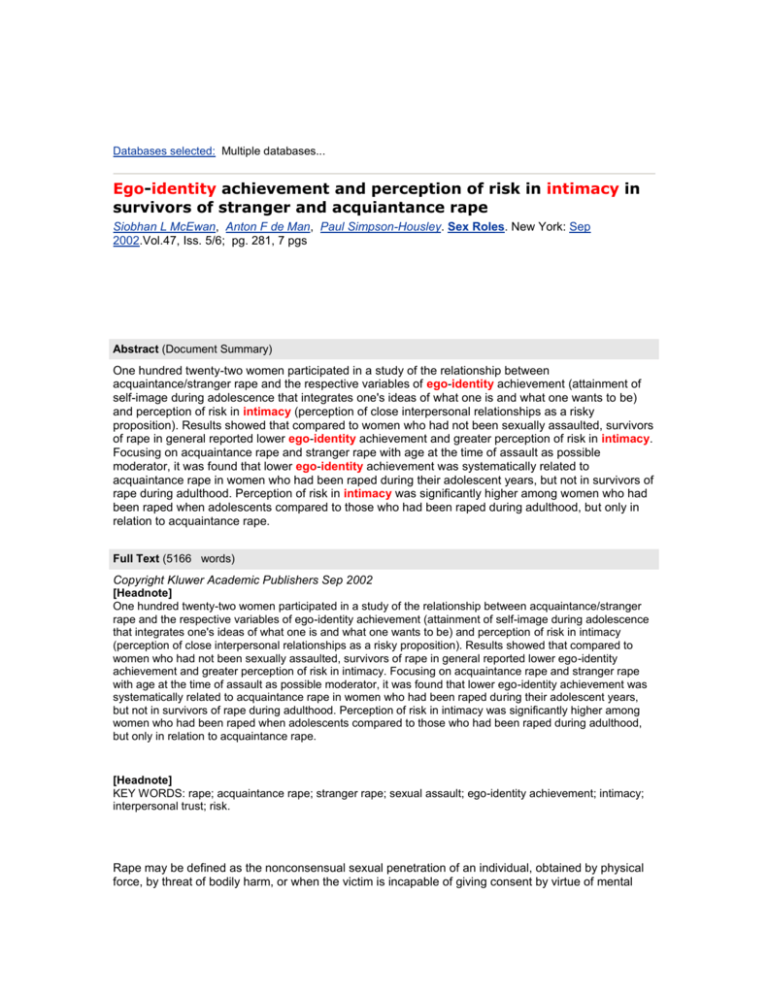
Databases selected: Multiple databases...
Ego-identity achievement and perception of risk in intimacy in
survivors of stranger and acquiantance rape
Siobhan L McEwan, Anton F de Man, Paul Simpson-Housley. Sex Roles. New York: Sep
2002.Vol.47, Iss. 5/6; pg. 281, 7 pgs
Abstract (Document Summary)
One hundred twenty-two women participated in a study of the relationship between
acquaintance/stranger rape and the respective variables of ego-identity achievement (attainment of
self-image during adolescence that integrates one's ideas of what one is and what one wants to be)
and perception of risk in intimacy (perception of close interpersonal relationships as a risky
proposition). Results showed that compared to women who had not been sexually assaulted, survivors
of rape in general reported lower ego-identity achievement and greater perception of risk in intimacy.
Focusing on acquaintance rape and stranger rape with age at the time of assault as possible
moderator, it was found that lower ego-identity achievement was systematically related to
acquaintance rape in women who had been raped during their adolescent years, but not in survivors of
rape during adulthood. Perception of risk in intimacy was significantly higher among women who had
been raped when adolescents compared to those who had been raped during adulthood, but only in
relation to acquaintance rape.
Full Text (5166 words)
Copyright Kluwer Academic Publishers Sep 2002
[Headnote]
One hundred twenty-two women participated in a study of the relationship between acquaintance/stranger
rape and the respective variables of ego-identity achievement (attainment of self-image during adolescence
that integrates one's ideas of what one is and what one wants to be) and perception of risk in intimacy
(perception of close interpersonal relationships as a risky proposition). Results showed that compared to
women who had not been sexually assaulted, survivors of rape in general reported lower ego-identity
achievement and greater perception of risk in intimacy. Focusing on acquaintance rape and stranger rape
with age at the time of assault as possible moderator, it was found that lower ego-identity achievement was
systematically related to acquaintance rape in women who had been raped during their adolescent years,
but not in survivors of rape during adulthood. Perception of risk in intimacy was significantly higher among
women who had been raped when adolescents compared to those who had been raped during adulthood,
but only in relation to acquaintance rape.
[Headnote]
KEY WORDS: rape; acquaintance rape; stranger rape; sexual assault; ego-identity achievement; intimacy;
interpersonal trust; risk.
Rape may be defined as the nonconsensual sexual penetration of an individual, obtained by physical
force, by threat of bodily harm, or when the victim is incapable of giving consent by virtue of mental
illness, mental retardation, or intoxication (Koss & Harvey, 1991). Estimates of the prevalence of rape
vary from one in three women to one in five (Kilpatrick, Saunders, Veronen, Best, & Von, 1987;
Pollard, 1993; Wyatt, 1992). In the majority of cases, rape is committed by individuals known to their
victims (Koss, Dinero, Seibel, & Cox, 1988), including former or current partners (Burge, 1983;
Finkelhor & Yllo, 1985; Koss & Harvey, 1991) or individuals with whom the victims were romantically
involved (Kilpatrick et al., 1987). In the remaining cases, the assailants are complete strangers. Rape
has been the focus of much research on topics such as attitudes toward victims, attribution of blame,
rape-reporting rates, prevalence rates, and effects on survivors (e.g., Barnett, Quackenbush, Sinisi, &
Wegman, 1992; Bell, Kuriloff, & Lottes, 1994; Bridges, 1991; Browne, 1992; Dekeseredy, Schwartz, &
Tait, 1993; Johnson & Jackson, 1988; Johnson & Russ, 1989; Kanekar & Seksaria, 1993; Kormos &
Brooks, 1994; Levine-MacCombie & Koss, 1986; Pollard, 1993; Quackenbush, 1989; Stacy, Prisbell, &
Tollefsrud, 1992; Vicary, Klingaman, & Harkness, 1995; Wyatt, 1992). A number of studies have
focussed on the possible differential effect of stranger versus acquaintance rape, but the results have
been inconsistent. Early investigators reported either that stranger rape survivors demonstrated the
most extreme symptomatology or that there was little or no difference in the outcomes of stranger
versus acquaintance rape (e.g., Atkeson, Calhoun, Resick, & Ellis, 1982; Becker, Skinner, Abel, &
Treacy, 1984; Frank, Turner, & Stewart, 1980; Koss et al., 1988). More recent research, on the other
hand, suggests that stranger rape and acquaintance rape show enough distinction to be regarded as
related but distinct traumatic events (e.g., Karp, Silber, Holmstrom, & Stock, 1995; Ullman & Siegel,
1993). There are indications that rape by an acquaintance is at least as debilitating as rape by a
stranger (Browne, 1992), and indeed may be more devastating with longer lasting symptomatology in
certain areas of psychological functioning, such as self-blame, negative self-image, and impaired
social relations (Cohen & Roth, 1987; Gidycz & Koss, 1991; Kanekar & Seksaria, 1993; Karp et al.,
1995; Kormos & Brooks, 1994; Tetreault & Barnett, 1987; Ullman & Siegel, 1993).
In this study we investigated the relationship between rape trauma in general and the (Erikson-based) variables of ego-identity achievement and perception of risk in intimacy. Furthermore, we
studied the possible moderating effect of age at the time of first assault on the association between
acquaintance/stranger rape and the respective personality characteristics.
Erikson (1968) proposed that adolescence is a time when young people are struggling with issues of
identity. Youngsters try to find out who they are and who they are not; they search for new roles to help
them discover their sexual, ideological, and occupational identities. Over time, they form their own
selfimages, which integrate their ideas about themselves and about what others think of them. If this
process is resolved satisfactorily, ego-identity is achieved and the result is a consistent and congruent
picture of self. Erikson saw a positive resolution of the identity versus identity confusion crisis as
necessary before there could be a positive resolution of the intimacy versus isolation crisis that lies at
the center of the next psychosocial stage of young adulthood. People who have acquired a solid sense
of who they are will be able to fuse their identity with the identity of another person and develop
intimacy. Because intimacy can only be achieved after people have developed a stable ego, people
who are unsure of their identity may perceive risk in intimacy and may shy away from it. They may
distance themselves from others, have few close friends, find it difficult to establish romantic
involvements, and be less extroverted and sociable.
Personality, which includes ego-identity achievement and acquisition of intimacy, is shaped by a
multiplicity of experiences. Some of these are traumatic in nature and, as such, may interfere with the
development of ego-identity and intimacy. People make assumptions about themselves and the world,
and these assumptions form the basis of a personal theory of reality. The latter brings a sense of order
in their lives and influences their choices and actions, but it often cannot account for traumatic events
(Janoff-Bulman, 1985, 1989; Janoff-Bulman & Frieze, 1983). People make assumptions about
themselves (e.g., I am a valuable, good person). These assumptions are threatened by trauma such
as rape. Victims may regard their own personality make-up as the cause of the trauma, and in
response, they may develop a negative self-image. People also make assumptions about their
personal invulnerability (e.g., bad things won't happen to me), assumptions that include the sense that
other people and the world are generally benevolent. When the assumption of benevolence is
challenged, people's sense of safety and security is lost. When this happens through rape trauma, the
survivors can no longer feel safe with others because it was another person who inflicted the trauma.
In this context, it might be expected that survivors of rape (regardless of the type of rape) would report
lower ego-identity achievement and would perceive greater risk in intimacy than would women who
have not been sexually assaulted.
Regarding the differential effect of acquaintance rape versus stranger rape, it has been found that
survivors of acquaintance rape tend to hold more negative self-images, experience greater self-blame,
and more often believe that they are unable to control situations (Katz, 1991; Katz & Burt, 1988; Koss
et al., 1988). Victims who most trusted their assailants prior to the rape demonstrate the least positive
self-concept and most self-blame following the rape (Katz, 1991). Furthermore, because acquaintance
rape involves the betrayal and violation of trust by an individual previously considered safe, women
who have been sexually assaulted by a person they knew are more likely to assess the world, and the
people in it, as unsafe and dangerous (Scheppele & Bart, 1983). Considering these negative changes
in perception of self and others, it would not be surprising if survivors of acquaintance rape were to
report lower ego-identity achievement and greater perception of risk in intimacy than stranger rape
victims.
However, the respective associations may be affected by a third variable: age at the time of first sexual
assault. It has been found that assault at a younger age has a greater effect on future development
(Burnam et al., 1988; Finkelhor & Dzuiba-Leatherman, 1994; McFarlane, 1989). Youngsters have not
yet developed strong self-capacities and ego-resources, and they are more likely to show disruptions
in their perceptions of self and others when faced with trauma. Adults, on the other hand, generally
have a relatively robust sense of identity, intimacy, and sufficient ego-resources to withstand an
assault on the self. Because acquaintance rape has been found to affect attitudes toward self and
others, and because adolescents are still in the process of forming an identity, which in turn will
facilitate the development of intimacy, it might be speculated that any differences between
acquaintance rape and stranger rape survivors in terms of ego-identity achievement and perception of
risk in intimacy should be found among victims who were raped when they were adolescents rather
than among survivors who were raped during adulthood.
There are several other variables that may systematically influence the outcome of the various
analyses. These include multiple assaults, time since assault, professional therapeutic intervention,
emotional support from family or friends following assault, and age at the time of testing. Koss et al.
(1988) noted that acquaintance rape survivors are twice as likely as stranger rape survivors to
experience multiple assaults by the same assailant. This places them at a higher risk because sexual
revictimization has been identified as a strong predictor of long-lasting and extreme symptomatology
(Atkeson et al., 1982; Bremner & Brett, 1997; Briere, Elliot, Harris, & Cotman, 1995; Kilpatrick et al.,
1987). Regarding time since assault, Karp et al. (1995) and Ullman and Siegel (1993) reported that
initially there appears to be little difference between the responses of the two victim groups, but that in
the long term, survivors of acquaintance rape display more symptoms than survivors of stranger rape.
Support from external sources (i.e., therapeutic intervention or emotional support from family or
friends) may help rape survivors cope with their ordeal. However, Tetreault and Barnett (1987) found
that this type of support is more likely to be received by victims of stranger rape than victims of
acquaintance rape, who are more likely to be doubted or blamed. Finally, age at the time of testing
was included because achievement of ego-identity is age-related (i.e., respondents who were older at
the time of testing would have had more time to achieve ego-identity).
In summary, we hypothesized that survivors of rape in general would report lower ego-identity
achievement and would perceive greater risk in intimacy than would women who have not been
sexually assaulted. Furthermore, we expected that survivors of acquaintance rape would report lower
levels of ego-identity achievements and greater perceptions of risk in intimacy than would stranger
rape victims. However, we thought that any differences between acquaintance rape and stranger rape
survivors in terms of ego-identity achievement and perception of risk in intimacy should be found
among victims who were raped when they were adolescents and not among survivors who were raped
during adulthood.
METHOD
Participants
Participants were recruited from classrooms in various disciplines at a large urban university. Two
hundred fifty questionnaires were distributed. Of the 180 that were returned, 32 were incomplete and
26 came from women whose first sexual assault had occurred in childhood (< 12 years) or whose
unwelcome sexual experiences did not involve rape (unwanted kissing, fondling). These respondents
were not included in the analyses, leaving a total of 122 participants representing two groups. The first
group consisted of 48 women who had experienced acquaintance rape and 9 who were survivors of
stranger rape. The acquaintance rape group ranged in age from 19 to 52 years (M = 28.00, SD = 8.84)
and the stranger rape group varied in age from 20 to 42 years (M = 25.22, SD = 7.36). In terms of
ethno-racial background, 46.3% of the women were of European descent, 35.2% were of African
descent, 5.6% were of Asian descent, 7.4% were of Middle-Eastern descent, and 5.5% were
Indigenous people. The second group consisted of 65 women from comparable ethnoracial
backgrounds (42.9% European descent, 32.2 % African descent, 16.0% Asian descent, 7.1% Middle-Eastern descent, 1.8% Indigenous) who had not experienced sexual assault. They ranged in age from
19 to 50 years (M = 23.03, SD = 5.11).
Instruments and Procedures
Acquaintance/stranger rape status was established by the following questions: "Has anyone
succeeded in pressuring or forcing you into sexual activity?"; "Did the sexual activity include
intercourse?"; "What was your relationship to the person who abused you?" Respondents who
reported rape by an acquaintance or stranger were placed in the respective rape groups; those who
reported no unwanted sexual activity were placed in the control group.
Information regarding number of assaults, age at time of first assault, age at time of testing,
therapeutic intervention, emotional support from family or friends, and ethno-racial origin was obtained
by questionnaire.
Achievement of ego-identity was assessed by the Ego-Identity Scale (Tan, Kendis, Fine, & Porac,
1977). This 12-item forced-choice instrument measures the extent to which respondents have
successfully negotiated Erikson's fifth-stage conflict between ego-identity and identity diffusion
(Erikson, 1968). The items reflect Erikson's characterizations of ego-- identity achievement (true
identity achievement, not foreclosure). Each one consists of two statements: one indicates egoidentity, and the other indicates identity-diffusion. High scores reflect greater ego--identity
achievement. Tan et al. (1977) reported an odd-even, split-half reliability of .68 for the scale and factor
analysis results that identified one factor, which accounted for 40% of the variance.
Perception of risk in intimacy was assessed by the Risk in Intimacy Inventory (Pilkington & Richardson,
1988), which contains 10 items scored on 6-point scales (strongly disagree to strongly agree). This
scale measures perception of risk in close relationships. Respondents who see intimacy as a risky
proposition tend to distance themselves from others, have few close friends, and are less extroverted
and sociable. High scores reflect high levels of risk perception. The 10 items had a Cronbach's alpha
of .80, and a principal component analysis yielded only one principal factor, which accounted for 37%
of the variance (Pilkington & Richardson, 1988).
Informed consent was obtained, anonymity was guaranteed, and the women were told that if they
wished to stop their participation at any time, they were free to do so. The questionnaires were
administered in counterbalanced order to avoid a possible order effect. Respondents were debriefed,
and a psychotherapist was present during and following the administration of the questionnaires to
answer any questions and to provide support and referral when needed. Moreover, a list of support
resources was made available to the participants.
RESULTS
Two sets of analyses were performed. The first set compared the respective ego-identity
achievements and perceptions of risk in intimacy of women who had experienced rape (regardless of
the type of rape) and women who had not been sexually assaulted. The second set was limited to the
women in the acquaintance rape and stranger rape groups, and evaluated the relationship between
type of rape, time of first assault (adolescence or adulthood), and the respective variables of egoidentity achievement and perception of risk in intimacy.
In the first set of analyses, a preliminary test to verify group equality showed that the two groups of
women differed in terms of age at the time of testing: that is, the assaulted women (M = 27.56, SD =
8.63) were significantly older, F(1, 120) = 12.82, p < .0001, than the nonassaulted ones (M = 23.03,
SD = 5.11). Because development of ego-identity and intimacy is age related, the possible effect of
this age difference was controlled for in subsequent analyses. Analyses of covariance with age at the
time of testing as covariate showed that the two groups differed in terms of ego-- identity achievement,
F(1, 119) = 7.40, p < .008, and perception of risk in intimacy, F(1, 119) = 19.74, p < .0001. Compared
to the women who had never been assaulted, the rape survivors generally reported lower ego-identity
achievement (adjusted M = 6.26, SE = .32 vs. adjusted M = 7.46, SE = .29) and higher perception of
risk in intimacy (adjusted M = 37.27, SE = 1.52 vs. adjusted M = 27.78, SE = 1.42). Moreover, the
latter two variables were interrelated, pr = -.42, p < .0001; respondents with low ego-identity
achievement tended to perceive greater risk in intimacy.
In the second set of analyses, four groups were formed on the basis of type of assault (acquaintance
rape vs. stranger rape) and age at the time of first assault (adolescent vs. adult). Regarding the latter,
participants who were between the ages of 12 and 20 years at the time of first assault were placed in
the adolescent group; those who were older than 20 years formed the adult group. The resulting
groups were as follows: adolescent at the time of trauma and survivor of acquaintance rape (N = 38);
adolescent at the time of trauma and survivor of stranger rape (N = 6); adult at the time of trauma and
survivor of acquaintance rape (N = 10); adult at the time of trauma and survivor of stranger rape (N =
3).
The four groups were compared in terms of multiple assaults, time since assault, therapy following
assault, perceived emotional support from family or friends, and age at time of testing. Multiple
assaults were recorded if the respondent reported two or more sexual assaults (only one participant
reported more than two assaults); the four groups did not differ significantly in this respect. Time since
assault was measured in years by subtracting age at the time of first assault from age at the time of
testing; no significant differences were found between the groups. Variations in therapy and emotional
support following sexual assault were not significantly different. However, an analysis of variance
(Acquaintance/ Stranger Rape x Adolescent/Adult) of age at the time of testing showed a significant
interaction effect, F(1, 153) = 4.23, p < .045, which indicates that the four groups were not similar in
terms of this variable. Hence, the potential effect of age at the time of testing was controlled for in
subsequent analyses.
An analysis of covariance (Acquaintance/ Stranger Rape x Adolescent/Adult, with age at the time of
testing as covariate) of the ego-identity achievement scores found no significant main effect, F(1, 52) =
.57, p < .45, for type of rape (acquaintance rape adjusted M = 6.41, SE = .46; stranger rape adjusted
M = 7.18, SE = .90) nor for age at time of first assault, F(1, 52) = 1.10, p < .30 (adolescent adjusted M
= 7.31, SE = .55; adult adjusted M = 6.27, SE = .83), but did identify a significant interaction, F(1, 52) =
4.79, p < .03, between type of rape and age at the time of first assault. t tests revealed a significant
difference, t^sub 42^ = 2.74, p < .001, between the acquaintance rape (adjusted M = 5.80, SE = .41)
and stranger rape (adjusted M = 8.83, SE = 1.03) groups at the adolescent level but not at the adult
level (acquaintance rape adjusted M = 7.02, SE = .83; stranger rape adjusted M = 5.53, SE = 1.48).
An analysis of covariance (Acquaintance/ Stranger Rape x Adolescent/Adult, with age at the time of
testing as covariate) of the perception of risk in intimacy scores similarly found no significant main
effect, F(1, 52) = 2.58, p < .11, for type of rape (acquaintance rape adjusted M = 33.68, SE = 2.06;
stranger rape adjusted M = 41.09, SE = 4.05) nor for age at the time of first assault, F(1, 52) = .09, p <
.77 (adolescent adjusted M = 36.72, SE = 2.49; adult adjusted M = 38.05, SE = 3.72), but did identify a
significant interaction, F(1, 52) = 4.20, p < .05, between type of rape and age at the time of first
assault. t tests revealed a significant difference, 46 = 2.01, p < .05, between the adolescents (adjusted
M = 37.78, SE = 1.84) and adults (adjusted M = 29.58, SE = 3.73) at the acquaintance rape level but
not at the stranger rape level (acquaintance rape adjusted M = 35.66, SE = 4.62; stranger rape
adjusted M = 46.51, SE = 6.65).
DISCUSSION
Congruent with expectations, the findings showed that the trauma of rape in general was associated
with lower ego-identity achievement and greater perception of risk in intimacy. As might be anticipated
on the basis of Erikson's suggestion (Erikson, 1968) that failure to achieve ego-identity tends to lead to
difficulties in the subsequent psychosocial crisis of intimacy versus isolation, ego-identity achievement
and perception of risk in intimacy were interrelated. That is, respondents who were unsure of their
identity also tended to shy away from psychosocial intimacy. As stated, these identity and relationship
problems were more evident among rape survivors.
The initial impression was that survivors of acquaintance rape and stranger rape did not differ in terms
of ego-identity achievement. However, when age at which the first sexual assault took place was taken
into consideration, it became apparent that this variable had a moderating effect. Among survivors of
rape during adulthood, ego-identity achievement was not systematically related to the nature of the
relationship these women had had with their perpetrators, whereas among the women who were raped
during their adolescent years, nature of the relationship was associated with level of ego-identity
achievement. That is, in the adolescent group, survivors of acquaintance rape reported lower egoidentity achievements than did survivors of stranger rape. These findings were consistent with the
notion that adolescents, because they have not yet developed strong self-capacities and egoresources, are more vulnerable to the effects of rape, and the finding that acquaintance rape tends to
lead to more negative selfimages and self-blame.
The results regarding the relationship between acquaintance/stranger rape, age at the time of first
assault, and perception of risk in intimacy were puzzling: a pattern similar to the one found for egoidentity achievement was expected but not obtained. Once again, no difference was found between
the acquaintance rape and stranger rape groups. However, when age at the time of assault was
introduced into the equation, the analysis showed a significant difference in risk perception between
the adolescent and adult groups, but only in relation to acquaintance rape.
Women who have been raped have a need to make sense of the trauma, a need that may be satisfied
by making causal attributions. It might be speculated that women who have been raped by a stranger
are in a state of universal vulnerability (Perloff, 1983). That is, they believe that they are, like all
people, vulnerable to chance or external factors. Because the rape was perpetrated by a stranger
(something they could not have anticipated), they are able to externalize the blame and avoid selfblame. The assailant came from outside their social environment and not from within. As a result, they
are able to maintain their sense of intimacy with family and friends. Women who have been raped by a
person they knew, on the other hand, may be in a state of unique vulnerability. They may believe that
the experience was due to internal causes, traits, or behaviors unique to them. This belief may be
reinforced by the fact that they are often doubted or blamed for what happened (Kanekar & Seksaria,
1993; Kormos & Brooks, 1994; Tetreault & Barnett, 1987). As a result they may engage in self-blame.
More specifically, they may blame themselves for their failure to judge accurately the dangerousness
of the acquaintance who assaulted them. They may doubt their ability to assess the world around them
and others in their social environment. When this happens to an adolescent who is still in the process
of developing her personality and intimate friendships, the result may be a tendency to perceive
greater risk in intimacy.
In conclusion, these findings suggest that acquaintance rape and stranger rape are indeed associated
with different outcomes, but that these associations depend on the presence of a third variable. The
complicated nature of these relationships perhaps is an explanation for the conflicting results that have
been obtained in studies that, rather than focusing on the effects of rape in general, differentiated
between the two types of rape.
However, two limitations of the study must be noted. First, because of the relative rarity of stranger
rapes compared to acquaintance rapes, the stranger rape groups were relatively small in numbers.
Second, all participants in this study were university students. Consequently, the generalizability of the
results to the larger population may be limited. Research with different and larger groups utilizing the
same measures would clarify the applicability of these findings.
[Reference]
REFERENCES
[Reference]
Atkeson, B. M., Calhoun, K. S., Resick, P A., & Ellis, E. M. (1982). Victims of rape: Repeated assessment of
depressive symptoms. Journal of Consulting and Clinical Psychology, 50, 96-102.
Barnett, M. A., Quackenbush, S. W., Sinisi, C. S., & Wegman, C. M. (1992). Factors affecting reactions to a
rape victim. Journal of Psychology, 126, 609-620.
[Reference]
Becker, J. V., Skinner, L. J., Abel, G. G., & Treacy, E. C. (1984). Incidence and types of sexual dysfunctions
in rape and incest victims. Journal of Sex and Marital Therapy, 8, 65-74.
Bell, S. T, Kuriloff, P. J., & Lottes, I. (1994). Understanding attributions of blame in stranger rape and date
rape situations: An examination of gender, race identification, and student's social perceptions of rape
victims. Journal of Social Psychology, 24, 1719-1734.
[Reference]
Bremner, D. 1, & Brett, E. (1997). Trauma-related dissociative states and long-term psychopathology in
post-traumatic-- stress-disorder. Journal of Traumatic Stress, 10, 37-49.
Bridges, J. S. (1991). Perceptions of date and stranger rape: A difference in sex role expectations and rapesupportive beliefs. Sex Roles, 24, 291-307.
Briere, J., Elliot, D. M., Harris, K., & Cotman, A. (1995). Trauma symptom inventory: Psychometrics and
association with childhood and adult victimization in clinical samples. Journal of Interpersonal Violence, 10,
387-401.
Browne, A. (1992). Violence against women: Relevance for medical practitioners. Journal of the American
Medical Association, 23, 3184-3187.
[Reference]
Burge, S. K. (1983). Rape: Individual and family reactions. In C. R. Figley & H. I. McCubbin (Eds.), Stress
and the family: Vol. 2. Coping with catastrophe (pp. 103-119). New York: Bruner/Maze].
Burnam, M. A., Stein, J. A., Golding, J. M., Siegel, J. M., Sorenson, S. B., Forsythe, A. B., et al. (1988).
Sexual assault and mental disorders in a community population. Journal of Consulting and Clinical
Psychology, 56, 843-850.
Cohen, L. J., & Roth, S. (1987). The psychological aftermath of rape: Long-term effects and individual
differences in recovery. Journal of Social and Clinical Psychology, 5, 525-534.
Dekeseredy, W. S., Schwartz, M. D., & Tait, K. (1993). Sexual assault and stranger aggression on a
Canadian university campus. Sex Roles, 28, 263-277.
[Reference]
Erikson, E. M. (1968). Identity: Youth and crisis. New York: Norton.
Finkelhor, D., & Dzuiba-Leatherman, J. (1994). Victimization of children. American Psychologist, 3, 173-183.
Finkelhor, D., & Yllo, K., (1985). License to rape: Sexual abuse of wives. New York: Holt, Rinehart &
Winston.
Frank, E., Turner, S. M., & Stewart, B. D. (1980). Initial response to rape: The impact of factors within the
rape situation. Journal of Behavioral Assessment, 2, 39-53.
Gidycz, C. A., & Koss, M. P. (1991). Predictors of long-term sexual assault trauma among a sample of
victimized college women. Violence and Victims, 6, 175-190.
Janoff-Bulman, R. (1985). The aftermath of victimization: Rebuilding shattered assumptions. In C. R. Figley
(Ed.), Trauma and its wake: Vol. 2. The study and treatment of PTSD (pp. 15-35). New York: Brunner/Mazel.
Janoff-Bulman, R. (1989). Assumptive worlds and the stress of traumatic events: Applications of the schema
construct. Social Cognition, 7, 113-136.
Janoff-Bulman, R., & Frieze, I. H. (1983). A theoretical perspective for understanding reactions to
victimization. Journal of Social Issues, 39, 1-17.
[Reference]
Johnson, J. D., & Jackson, L. A. (1988). Assessing the effects of factors that might underlie the differential
perception of acquaintance and stranger rape, Sex Roles, 19, 37-45.
Johnson, J. D., & Russ, I. (1989). Effects of salience of consciousness-raising information on perceptions of
acquaintance versus stranger rape. Journal of Applied Social Psychology,19, 1182-1197.
Kanekar, S., & Seksaria, V. (1993). Acquaintance versus stranger rape: Testing the ambiguity reduction
hypothesis. European Journal of Social Psychology, 23, 485-494.
Karp, S. A., Silber, D. E., Holmstrom, R. W., & Stock, L. J. (1995). Personality of rape survivors as a group
and by relation of survivor to perpetrator. Journal of Clinical Psychology, 50, 587593.
Katz, B. L. (1991). The psychological impact of stranger versus nonstranger rape on victims' recovery. In A.
Parrot & L. Bechhofer (Eds.), Acquaintance rape: The hidden crime (pp. 251-269). New York: Wiley.
Katz, B. L., & Burt, M. R. (1988). Self-blame in recovery from rape: Help or hindrance? In A. W. Burgess
(Ed.), Rape and sexual assault: Vol. 2 (pp. 191-212). New York: Garland.
[Reference]
Kilpatrick, D. G., Saunders, B. E., Veronen, L. J., Best, C. L., & Von, J. M. (1987). Criminal victimization:
Lifetime prevalence, reporting to police, and psychological impact Crime and Delinquency, 33, 479-489.
Kormos, K. C., & Brooks, C. 1. (1994). Acquaintance rape: Attributions of victim blame by college students
and prison inmates as a function of relationship status of victim and assailant. Psychological Reports, 74,
545-546.
Koss, M. P., Dinero, T. E., Seibel, C., & Cox, S. (1988). Stranger, acquaintance, and date rape: Are there
differences in the victim's experience? Psychology of Women Quarterly, 12, 1-24.
[Reference]
Koss, M. P, & Harvey, M. (1991). !he rape victim: Clinical and community approaches to treatment.
Lexington, MD: Stephen Greene Press.
Levine-MacCombie, J., & Koss, M. P. (1986). Acquaintance rape: Effective avoidance strategies.
Psychology of Women Quarterly, 10, 311-319.
McFarlane, A. C. (1989). The treatment of posttraumatic stress disorder. British Journal of Medical
Psychology, 62, 81-90.
Perloff, L. S. (1983). Perceptions of vulnerability to victimization. Journal of Social Issues, 39, 46-61.
Pilkington, C. J., & Richardson, D. R. (1988). Perceptions of risk in intimacy. Journal of Social and Personal
Relationships, 5, 503-508.
Pollard, P (1993). Rape reporting as a function of victimoffender relationship: A critique of the lack of effect
[Reference]
reported by Bachman. Criminal Justice and Behavior, 22, 74-80.
Quackenbush, R. L. (1989). A comparison of androgynous, masculine sex-typed, and undifferentiated males
on dimensions of attitudes toward rape. Journal of Research in Personality, 23, 318-342.
Scheppele, K. L., & Bart, P. B. (1983). Through women's eyes: Defining danger in the wake of sexual
assault. Journal of Social Issues, 39, 63-81.
[Reference]
Stacy, R. D., Prisbell, M., & Tollefsrud, K. (1992). A comparison of attitudes among college students toward
sexual violence committed by strangers and by acquaintances: A research report. Journal of Sex Education
and Therapy, 18, 257-273.
Tan, A. L., Kendis, R. J., Fine, J. T, & Porac, J. (1977). A short measure of Ericksonian ego identity. Journal
of Personality Assessment, 41, 279-284.
Tetreault, P A., & Barnett, M. A. (1987). Reactions to stranger and acquaintance rape. Psychology of
Women Quarterly, 11, 353-358.
[Reference]
Ullman, S. E., & Siegel, J. M. (1993). Victim-offender relationship and sexual assault. Violence and Victims,
7, 121-134.
Vicary, J. R., Klingaman, L. R., & Harkness, W. L. (1995). Risk factors associated with date rape and sexual
assault of adolescent girls. Journal of Adolescence, 18, 289-306.
Wyatt, G. E. (1992). The sociocultural context of African American and White American women's rape.
Journal of Social Issues, 48, 77-92.
[Author Affiliation]
Siobhan L. McEwan,1 Anton E de Man,2,3 and Paul Simpson-Housley1
[Author Affiliation]
1 York University, Toronto, Ontario, Canada.
2Department of Psychology, Bishop's University, Lennoxville, Quebec, Canada.
3To whom correspondence should be addressed at Department of Psychology, Bishop's University,
Lennoxville, Quebec, Canada J1M 1Z7; e-mail: ademan@ubishops.ca.
More Like This - Find similar documents
Subjects:
Women
Self image
Risk
Rape
Perceptions
Author(s):
Siobhan L McEwan
Anton F de Man
Paul Simpson-Housley
Document types:
Feature
Language:
English
Publication title:
Sex Roles
^ Back to Top
« Back to Results
< Previous Document 2 of 2
Abstract ,
Mark Document
Publisher Information
Full Text ,
Full Text - PDF
Copyright © 2007 ProQuest Information and Learning Company. All rights reserved. Terms and Conditions
Text-only interface



